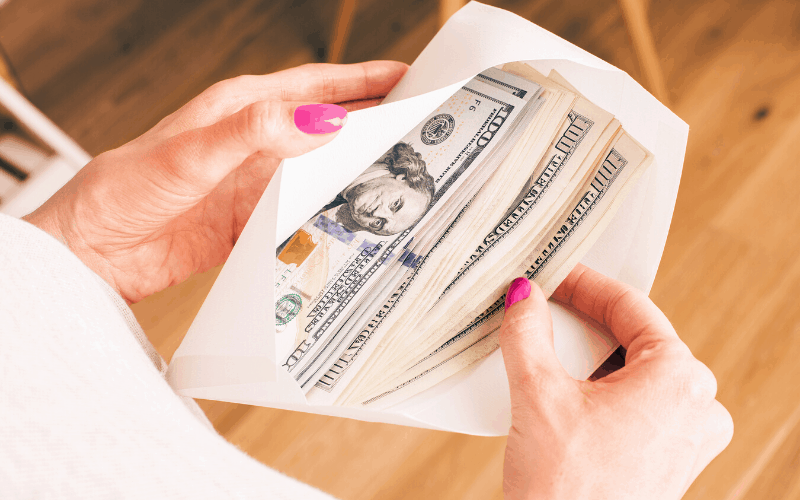What are sinking funds? When I first heard the term I thought they were going to be some overly complicated finance concept that it was going to hurt my head to understand. I needed the sinking funds for beginners guide.
To my surprise, sinking funds are amazingly simple to understand.
If the term scares you, don’t be afraid. ????
Keep reading and you will understand and be ready to add sinking funds to your budget in no time.
Note: This page contains affiliate links, which means that if you buy something using one of the links below, I may earn a commission.

What are Sinking Funds?
A Sinking Fund is a fund formed by periodically setting aside money for the gradual repayment of a debt or replacement of a wasting asset. Simply put, sinking funds are money that you save to meet a specific savings goal.
For example, if you are saving a set amount of money each month to buy you a car. You have a sinking fund.
Why Do You Need Sinking Funds?
Having sinking funds ultimately makes your budget stronger. They allow you to plan for expected expenses.
Chances are pretty good that sometime this year you will need to purchase gifts, replace something that regularly wears out, or renew an annual subscription or quarterly subscription.
If you are not actively planning for how you will pay for these items, they will have to come out of some other part of your budget. Which might be your emergency fund, your general savings, or your credit cards.
Sinking funds allow you to strategically plan for these types of expenses so you don’t have to resort to pulling money out of other areas.
Sinking funds will help you stop feeling like “something always happens” to mess up your money.

What’s the difference between Sinking Funds & Regular Savings?
So, what’s the difference between having sinking funds and just having a savings account. Well, with a sinking fund you are saving for a specific reason. The end goal is for that money to be spent.
With general savings, you are working to build wealth.
With sinking funds, you have specific goals. You know the purpose of the money you are saving and in most cases, you know exactly how much you are trying to save for that goal.
The money you are saving is targeted.
What’s the Difference Between a Sinking Fund and an Emergency Fund?
Ok, so what’s the difference between a sinking fund and an emergency fund?
The difference is simply the intention behind why the money is being saved. With an emergency fund, you are saving for the unknown. Your initial emergency fund has $1000 and your fully-funded emergency fund had 3 to 6 months or even a full year worth of your expenses saved.
This money is designed to be used when any type of unexpected emergency happens which could include a home repair, a medical emergency, or a job loss. You have no idea what you might need the money for, you just know that you want to have money set aside to help you just in case anything happens.
With sinking funds, you are saving for a known goal, and most of the time you know exactly when you’ll need the money and about how much you’ll need.
If I continue with my car example, you know that you are saving for a car and you have a pretty good idea how much money you’ll need to get the car that you want.
Another example might be saving money for Christmas. You pretty much know ahead of time who you want to buy Christmas gifts for and you can set a Christmas gift budget. You also might know if you will want to travel or host Christmas festivities at your home.
If you saved money for Christmas throughout the year this would be a sinking fund.

Sinking Fund Categories
Here is where I’m going to go back to what I tell you all the time. Personal finance is just that… personal.
Your sinking funds should be unique to you. They should fit your needs and savings goals.
With that said there are some that are pretty common for most people, some of these may be considered essential sinking funds.
House Sinking Fund
If you are a homeowner you know that upkeep on a house is a monster. My boyfriend and I often joke about the insane amount of lightbulbs that are needed in our house. Replacing them is no small expense.
While some things are covered by insurance, there are home repairs that are not. These are the items that could be planned for in your house sinking fund.
It’s hard to guess what repairs might be needed but in some cases, you will know when items are reaching end of life.
broken furnace, needing a new roof, replacing broken home appliances
If you don’t own your own home already, you can create a sinking fund to help you save for the down payment on a home.
Car Sinking Fund
This sinking fund can be used in two ways. It can be used to purchase a car or it can be used for maintenance.
Saving to purchase a car is pretty self-explanatory so let’s focus on maintenance for a minute.
No matter what type of car you have it will need maintenance. Tires wear out, you need oil changes and all types of other regular servicing that will need to be done to keep your car in good condition.
A car sinking fund can be used to save money for these items ahead of time and these expenses wouldn’t have to come out of other areas of your budget.
You know they are going to happen, so why not plan for them.
Christmas Sinking Fund
The Christmas holiday season can be very expensive. A Christmas Sinking Fund is a good way to plan for the things like gifts, travel, food, and other festivities.
Planning for these expenses in advance will take a lot of financial stress out of the Christmas holiday season.
Yearly Subscriptions Sinking Fund
Subscription expenses like annual credit card fees and Amazon Prime often go overlooked until that pop up in your checking account. If you’re like me you know that you have them but when it’s time for them to occur it is somewhat of a surprise. They are never apart of my normal budget.
Well, at lease they weren’t until I implemented sinking funds.
Setting up sinking funds for these types of expenses can get rid if those shocking charges.
Car Insurance
If you have a car, car insurance is a required expense. And in many cases it can be quite a sizable addition to your budget.
Paying your car insurance monthly and adding it as a regular expense on your budget is an option. However, paying it in the manner causes you to spend more money.
By creating a car insurance sinking fund, you can save money and pay your car insurance on a 6 month or annual basis. This can save you money each year because insurance companies offer discounts for paying on these schedules.

Family Vacation/ Travel
Taking time to travel and spend time with your family is very important to your quality of life. It helps you to relax and build lasting memories.
A travel or vacation sinking fund allows you to plan for your travel expenses in advance each year making it financially easier for you to travel. This is especially true if you have a large family.
Back-to-School Sinking Fund
Back-to-school is an exciting time which also comes with expenses. The cost of school clothes, shoes, uniforms, and school supplies can really add up.
A Back-to-school sinking fund is a way to tackle these expenses with ease each year.
Kids Sports Sinking Fund
School Sports and extracurricular activities are other types of expenses that can hit the budgets of parents unexpectedly. It can cost hundreds of dollars to cover the cost of these types of activities.
Setting up a Kids Sports sinking fund can help reduce the financial blow of keeping your kids active in sports.
Medical Sinking Fund
Even if you do have insurance medical expenses can be a bit much. Things like copays, over the counter medicines, prescriptions, dentist visits, eye doctor visits, glasses, and contacts are extra expenses that are normally missed in our budgets.
Setting up a medical sinking fund will give you the padding needed in your budget to cover these types of expenses.

How Much Money Should be in Your Sinking Fund?
The beauty of sinking funds is that you have some information available to help you determine exactly how much money should be in your sinking fund and how much you will need to contribute to it each month or pay period.
Let’s stick with the purchasing a car scenario.
You know how much money you will need for the down payment or the full payment and you can give yourself a set amount of time to purchase your car. Or because you have a budget you know how much money you have to save towards a car and you can let that determine the time it will take you to have enough money for the purchase.
Either way, you have enough information to know how much money you need and how much you should save each month.
In general, when creating your sinking funds you’ll need to do the following:
- Determine the amount that you want to save
- Decide how many months you want to save over
- Divide the amount needed by the number of months
- Put that amount into your sinking fund
You’ll need to do this for each one of the sinking funds that you decide to create.

Where Should You Keep Your Sinking Funds?
Now that we have a clear view of what sinking funds are and how we can use them to save for specific purposes, let’s talk about the different places you can keep your sinking funds.
Sinking Fund Envelopes
The first method is Sinking Fund Cash Envelopes.
If you currently use the cash envelope budgeting method then this one will fall right in line with what you are already doing to manage your money.
In this method, you would create sinking fund envelopes and you would place cash in the envelopes each pay period. With this method, you can use really cute paper trackers to track your progress.
You can find sinking fund envelopes and labels in the HWS Shop. We’ll be adding new designs often to keep them fresh. I’ll leave a link in the description so you can go and check them out.
I’ll also leave links to some free printable sinking fund trackers that you can download and print on your own.
Digital Sinking Funds – Savings Accounts
Another method you can use is Savings Accounts.
With this method, you would use different savings accounts for each one of your sinking funds. The goal here is to keep each sinking fund separate so you have a clear view as to how much you have in each sinking fund.
With this method, you’ll need to be careful about bank fees. You don’t want to accumulate bank fees on multiple savings accounts. I would recommend you wanting my videos on the best high yield savings accounts and the best bank accounts.
You’ll find some good options on free savings accounts that you can use for your sinking funds.
I use Ally Bank and they have a really cool feature in their high yield savings account that is perfect for sinking funds. In one savings account, you can set up categories for your savings. You can think of these categories as your sinking funds.
This feature will allow you to track your sinking funds using one savings account.
You can find more information on the best banks accounts and savings accounts in these videos.
Now you should have a clear understanding of what sinking funds are and how they can help you. In my next video, we’ll talk about how you can add sinking funds into your budget and I’ll go deeper into ways of tracking your sinking funds.
Don’t forget to Like, Share, Tweet, and Pin this post.


